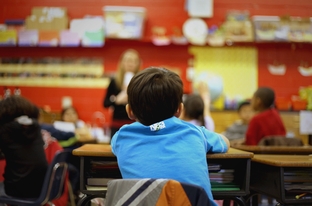Behind the Class of 2014, Texas' Demographic Future

When the high school class of 2014 graduates this spring, it will mark the beginning of a new era for Texas public schools.
The current crop of seniors will likely be among the last not containing a majority of Hispanic students. It will also, based on preliminary enrollment data from the 2012-13 school year, probably fall among the last without a majority of students from impoverished backgrounds.
Neither milestone is a surprise — they come as a result of longstanding demographic shifts in Texas public schools.
Hispanics became the majority of total public school students for the first time in 2011, growing by about 10 percentage points over the decade since 2000. Since that same year, the overall percentage of economically disadvantaged students has also grown, from less than half to 60 percent of all public school students — more than double a 20 percent increase in the public school population as a whole. But the bulk of those students are concentrated in the younger grades, with the percentage from economically disadvantaged backgrounds steadily declining to a low of 46 percent in the class of 2012, the latest year data is available. That is soon set to change as the population of students in the lower grades make their way through the school system.
Texas' numbers stand out even more in a national context. In the same period, public school enrollment only grew by about 5 percent overall. Hispanic student populations increased by about 6.5 percent nationally.
Both trends are expected to continue. An analysis from Steve Murdock, director of Rice University’s Hobby Center for the Study of Texas, shows that of the roughly 979,000 children added to the state’s under-18 population from 2000 to 2010, about 931,000 were Hispanic. By 2050, Murdock’s projection shows, the number of Texas public school students is expected to swell to 9 million from roughly 5 million now, and nearly two-thirds will be Hispanic. The overall percentage of Anglo students will drop by half to about 15 percent.
The changes present both challenges and opportunities to Texas public schools. According to state data, Hispanic students have been statistically less likely to leave high school with a diploma than their Anglo peers. Of the Hispanic students who do graduate, few are prepared for college. In 2011, 42 percent met college-readiness benchmarks in both English and math, compared with 65 percent of Anglo students. Among economically disadvantaged students and those with limited English proficiency, the gap continues to widen. Thirty-eight percent of students who came from low-income households did well enough on their Texas Assessment of Knowledge and Skills or college entrance exams to qualify as “college ready.” Only 5 percent of those with limited English language skills did so.
But the state has shown improvement in academic achievement for both Hispanic and economically disadvantaged students. In 2012, it climbed to 84.3 percent for Hispanic students and 85 percent for those from impoverished backgrounds. That’s up from 68.5 and 69 percent, respectively, in 2007.
How Texas public schools navigate the demographic shift — and whether the Legislature has provided enough resources for them to do so successfully — is a focus of an ongoing lawsuit over the state’s school finance system. Hearings in that case, which will consider changes made in the latest legislative session, are set to resume in January 2014.

